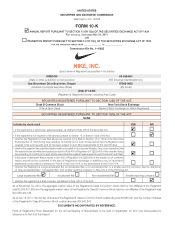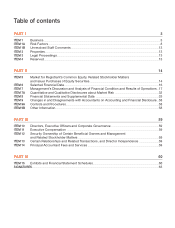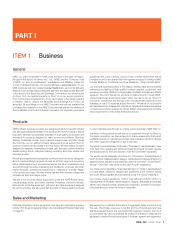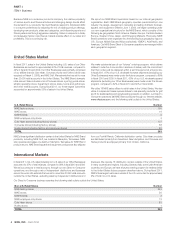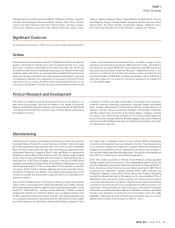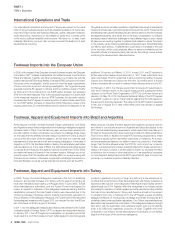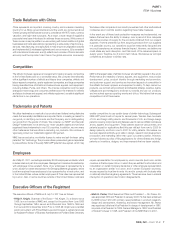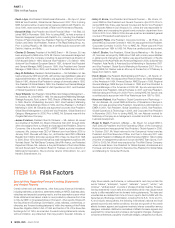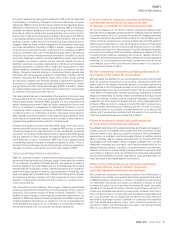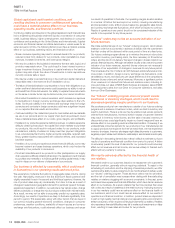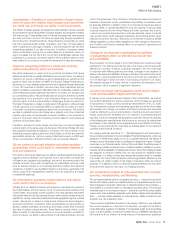Nike 2011 Annual Report Download - page 10
Download and view the complete annual report
Please find page 10 of the 2011 Nike annual report below. You can navigate through the pages in the report by either clicking on the pages listed below, or by using the keyword search tool below to find specific information within the annual report.10 NIKE,INC.-Form10-K
PARTI
ITEM1ARisk Factors
Global capital and credit market conditions, and
resulting declines in consumer confi dence and spending,
couldhave a material adverse effect on our business,
operating results, and fi nancial condition.
Continuing volatility and disruption in the global capital and credit markets have
led to a tightening of business credit and liquidity, acontraction of consumer
credit, business failures, higher unemployment, and declines in consumer
confi dence and spending in the UnitedStates and internationally.If global
economic and fi nancial market conditions deteriorate or remain weak for an
extended period of time, the following factors could have a material adverse
effect on our business, operating results, and fi nancial condition:
•
Slower consumer spending may result in reduced demand for our products,
reduced orders from retailers for our products, order cancellations, lower
revenues, increased inventories, and lower gross margins.
•
We may be unable to fi nd suitable investments that are safe,liquid, and
provide a reasonable return.This could result in lower interest income or
longer investment horizons.Disruptions to capital markets or the banking
system may also impair the value of investments or bank deposits we
currently consider safe or liquid.
•We may be unable to access fi nancing in the credit and capital markets at
reasonable rates in the event we fi nd it desirable to do so.
•
The failure of fi nancial institution counterparties to honor their obligations to us
under credit and derivative instruments could jeopardize our ability to rely on
and benefi t from those instruments.Our ability to replace those instruments
on the same or similar terms may be limited under poor market conditions.
•
We conduct transactions in various currencies, which increase our exposure
to fl uctuations in foreign currency exchange rates relative to the U.S.
dollar.Continued volatility in the markets and exchange rates for foreign
currencies and contracts in foreign currencies could have a signifi cant impact
on our reported fi nancial results and condition.
•
Continued volatility in the markets and prices for commodities and raw materials
we use in our products and in our supply chain (such as petroleum) could
have a material adverse effect on our costs, gross margins, and profi tability.
•
If retailers of our products experience declining revenues, or retailers experience
diffi culty obtaining fi nancing in the capital and credit markets to purchase
our products, this could result in reduced orders for our products, order
cancellations, inability of retailers to timely meet their payment obligations
to us, extended payment terms, higher accounts receivable, reduced cash
fl ows, greater expense associated with collection efforts, and increased
bad debt expense.
•
If retailers of our products experience severe fi nancial diffi culty, some may
become insolvent and cease business operations, which could reduce the
availability of our products to consumers.
•
If contract manufacturers of our products or other participants in our supply
chain experience diffi culty obtaining fi nancing in the capital and credit markets
to purchase raw materials or to fi nance general working capital needs, it may
result in delays or non-delivery of shipments of our products.
Our business is affected by seasonality, which could result
in fl uctuations in our operating results and stock price.
We experience moderate fl uctuations in aggregate sales volume during
theyear. Historically, revenues in the fi rst and fourth fi scal quarters have
slightly exceeded those in the second and third fi scal quarters. However, the
mix of product sales may vary considerably from time to time as a result of
changes in seasonal and geographic demand for particular types of footwear,
apparel and equipment. In addition, our customers may cancel orders, change
delivery schedules or change the mix of products ordered with minimal notice.
As a result, we may not be able to accurately predict our quarterly sales.
Accordingly, our results of operations are likely to fl uctuate signifi cantly from
period to period. This seasonality, along with other factors that are beyond
our control, including general economic conditions, changes in consumer
preferences, weather conditions, availability of import quotas and currency
exchange rate fl uctuations, could adversely affect our business and cause
our results of operations to fl uctuate. Our operating margins are also sensitive
to a number of factors that are beyond our control, including manufacturing
and transportation costs, shifts in product sales mix, geographic sales trends,
and currency exchange rate fl uctuations, all of which we expect to continue.
Results of operations in any period should not be considered indicative of the
results to be expected for any future period.
“Futures” orders may not be an accurate indication of our
future revenues.
We make substantial use of our “futures” ordering program, which allows
retailers to order fi ve to sixmonths in advance of delivery with the commitment
that their orders will be delivered within a set period of time at a fi xed price.
Our futures ordering program allows us to minimize the amount of products
we hold in inventory, purchasing costs, the time necessary to fi ll customer
orders, and the risk of non-delivery. We report changes in futures orders in our
periodic fi nancial reports. Although we believe futures orders are an important
indicator of our future revenues, reported futures orders are not necessarily
indicative of our expectation of changes in revenues for any future period.
This is because the mix of orders can shift between advance/futures and at-
once orders. In addition, foreign currency exchange rate fl uctuations, order
cancellations, returns, and discounts can cause differences in the comparisons
between futures orders and actual revenues. Moreover, a signifi cant portion
of our revenue is not derived from futures and advance orders, including at-
once and close-out sales of NIKE Brand footwear and apparel, sales of NIKE
brand equipment, sales from our Direct to Consumer operations, and sales
from our Other Businesses.
Our “futures” ordering program does not prevent excess
inventories or inventory shortages, which could result in
decreased operating margins and harm to our business.
We purchase products from manufacturers outside of our futures ordering
program and in advance of customer orders, which we hold in inventory and
resell to customers. There is a risk we may be unable to sell excess products
ordered from manufacturers. Inventory levels in excess of customer demand
may result in inventory write-downs, and the sale of excess inventory at
discounted prices could signifi cantly impair our brand image and have an
adverse effect on our operating results and fi nancial condition. Conversely, if we
underestimate consumer demand for our products or if our manufacturers fail
to supply products we require at the time we need them, we may experience
inventory shortages. Inventory shortages might delay shipments to customers,
negatively impact retailer and distributor relationships, and diminish brand loyalty.
The diffi culty in forecasting demand also makes it diffi cult to estimate our future
results of operations and fi nancial condition from period to period. A failure
to accurately predict the level of demand for our products could adversely
affect our net revenues and net income, and we are unlikely to forecast such
effects with any certainty in advance.
We may be adversely affected by the fi nancial health of
our retailers.
We extend credit to our customers based on an assessment of a customer’s
fi nancial condition, generally without requiring collateral. To assist in the
scheduling of production and the shipping of seasonal products, we offer
customers the ability to place orders fi ve to sixmonths ahead of delivery under
our “futures” ordering program. These advance orders may be cancelled,
and the risk of cancellation may increase when dealing with fi nancially ailing
retailers or retailers struggling with economic uncertainty. In the past, some
customers have experienced fi nancial diffi culties, which have had an adverse
effect on our business. As a result, retailers may be more cautious than usual
with orders as a result of weakness in the retail economy. A slowing economy
in our key markets could have an adverse effect on the fi nancial health of
our customers, which in turn could have an adverse effect on our results of
operations and fi nancial condition. In addition, product sales are dependent
in part on high quality merchandising and an appealing store environment to
attract consumers, which requires continuing investments by retailers. Retailers
who experience fi nancial diffi culties may fail to make such investments or delay
them, resulting in lower sales and orders for our products.

